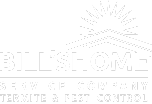The desert landscape of Vail, Arizona is home to a variety of unique and fascinating creatures, including centipedes. While these multi-legged arthropods play an important role in the ecosystem by feeding on insects and other small pests, they can be an unwelcome sight inside homes. Understanding the types of centipedes found in our region and how to prevent them from invading your space can help you keep your home centipede-free.
Common Centipedes in Southern Arizona
Southern Arizona is home to several species of centipedes, but the most commonly encountered ones include:
Giant Desert Centipede (Scolopendra heros)

- One of the largest centipedes in North America, growing up to 8 inches long
- Reddish-orange body with dark bands and yellow legs
- Possesses venomous fangs that can deliver a painful bite, similar to a bee sting
- Feeds on insects, spiders, small lizards, and even rodents
Common Desert Centipede (Scolopendra polymorpha)
- Typically 4-6 inches in length
- Yellow to brown body with dark stripes
- Venomous, though its bite is not dangerous to most humans, but can cause swelling and pain
- Active hunters that prey on cockroaches, crickets, and other small insects
House Centipede (Scutigera coleoptrata)
- Smaller species, usually around 1-2 inches long
- Recognizable by its long, thin legs and fast movements
- Prefers damp, dark environments like bathrooms and crawl spaces
- Feeds on household pests such as ants, termites, and bed bugs
Preventative Measures to Keep Centipedes Out
While centipedes play a beneficial role in controlling other pest populations, most homeowners prefer to keep them outside where they belong. Here are some effective preventative measures:
- Seal Entry Points – Centipedes enter homes through small cracks and crevices. To prevent access:
- Seal gaps around doors, windows, and foundation cracks
- Install door sweeps and weather stripping
- Repair damaged screens on windows and vents
- Reduce Moisture – Centipedes thrive in damp environments. Minimizing moisture can make your home less attractive to them:
- Fix any leaking pipes or faucets
- Keep bathrooms and crawl spaces dehumidified
- Ensure proper drainage around your home’s foundation
- Eliminate Their Food Source(s) – Centipedes feed on other small insects, so controlling their food supply can help deter them:
- Keep your home free of cockroaches, ants, and other pests
- Store food in sealed containers and clean up crumbs promptly
- Regularly take out the trash and dispose of organic waste properly
- Maintain Your Yard – A well-kept yard can reduce the likelihood of centipedes getting too close to your home:
- Trim overgrown vegetation near the foundation
- Remove leaf litter, woodpiles, and debris where centipedes may hide
- Keep mulch and rocks away from the perimeter of your home
- Consider Professional Pest Control – If centipedes continue to be a problem, professional pest control services can provide targeted treatments to keep them at bay. At Bill’s Home Service Company, we offer expert pest control solutions designed for the unique challenges of Southern Arizona.
Centipedes may be beneficial predators in the wild, but they’re not welcome house guests. By taking proactive steps to seal your home, reduce moisture, and eliminate their food sources, you can significantly reduce the chances of a centipede infestation. If you need professional help, contact Bill’s Home Service Company today to keep your home pest-free! For more information or to schedule a service, call us at (520) 625-2381 or contact us here.
